Tanks and armored cars
About 4,545 AFVs produced locally and 5,000+ provided
Tanks
- AC I Sentinel Cruiser Tank
- Matilda Dozer
- Matilda Frog and ‘Murray FT’ Flame Tank
- Matilda II in Australian Service
Prototypes & Projects
- AC II Cruiser Tank
- AC III Thunderbolt Cruiser Tank
- AC IV 17-pdr Armed Sentinel Cruiser Tank
- Bloomfield’s ‘Tortoise’ Single Track Heavy Tank
- Cossor Land Cruiser
- G. Crowther’s ‘Land Fortress Tank’
- Gerrey Machine Gun Motor Vehicle
- Grasshopper Light Tank
- Matilda Hedgehog
- Melvaine’s Mobile Pill Box
- Modra Revolving Light Tank
- Puckridge’s Land Battleship
- Wales-Whitehead Amphibian Tank
- Wentworth Cruiser Tank
Prologue
The roots of the Australian armored service can be traced back to the latter part of the First World War. Australian troops were indeed committed in action with British tanks, working on close cooperation tactics, notably at the Battle of Hamel (June 1918) and Amiens (August 1918). After WWI, the idea of integrating mechanized elements in traditional cavalry units was constantly on the minds of military men. By 1927, two independent tank sections were raised with four Vickers Medium Mark II tanks provided by the UK. The first was based in New South Wales as a part-time militia unit. However, the great depression of 1930 stopped all development on the matter, whereas a regular tank cadre at least maintained some basic instruction. The 1st Tank Section was disbanded and replaced by the 1st Light Tank Company (Randwick, New South Wales) and the 2nd Light Tank Company (Caulfield, Victoria) in 1937. In 1939, ten Light Tank Mark VIa were obtained from Great Britain and completed the units. In the meantime, the 1st Royal New South Wales Lancers were fully motorized. It became the 1st Armoured Regiment, entirely re-equipped with Matilda tanks.
Situation in 1939
After the start of the war in 1939, the government saw itself capped by limitations of the Defence Act (1903), which imposed only local militias, which could not leave the territory. An all-volunteer force to serve overseas was therefore raised, known as the Second Australian Imperial Force (2nd AIF), as well as the 2/2nd Machine Gun Battalion, composed of elements of the 1st Light Horse (Machine Gun). By 1940, although there was a sizable infantry force, the armor available was scarce, counting only the ten Mark VIs and four Mark IIs previously delivered. The first were only armed with a machine-gun, while the last were obsolete.
Australian forces in Africa and the Middle East
A commission was raised to investigate deliveries from Great Britain and the USA. While the latter provided thirteen M3 light tanks, which arrived in September 1941 (and 400 in total until mid-1942), the delivery of 140 Matilda IIs only started in July 1942. Part of the 1st Armoured Division (1st and 2nd Light Tank Companies) was disbanded or used to create the 3rd Armoured Regiment and the tanks were reaffected to the AFV School at Puckapunyal (Seymour, Victoria). At the same time, the four infantry divisions of the 2nd AIF received a core of light tanks and scout carriers for reconnaissance, but only three divisional cavalry regiment were formed actually, excluding the 8th Division fighting in the Malayan jungles.
These recce units were equipped primarily with Universal Carriers (Light Tanks were supplied later) and operated in North Africa. They captured Tobruk on 22 January and were part of Operation Compass, and the 6th Division Cavalry Regiment bolstered its own ranks with many captured Italian M11/39 tanks. Large kangaroos were painted for easier recognition. The same units were later deployed against Vichy French in Syria, involved notably in the “mad mile” battle. The 7th Division Cavalry Regiment operated in Cyprus in May 1941, and the 9th Division Cavalry Regiment also operated in Syria, receiving for the first time Crusader Mark IIs and M3 Stuart light tanks. Some of the captured French Renault R35s were also used. However, starting in mid-1942 and up to 1944, these regiments were converted to commandos and sent to the Pacific Theater as dismounted infantry.
The 1st Armoured Division, part of the 2nd AIF, was provisionally equipped with Universal Carriers for basic instruction, until the awaited deliveries. In April-May 1942, it received M3 Grant medium tanks and M3 Stuart light tanks, concentrated in the New South Wales to complete their training and extended exercised in Narrabi.
ANZAC’s in the Pacific and South-eastern Asia
The 2/6th Armoured Regiment from the 1st Armoured Division was deployed in Port Moresby and Milne bay in New Guinea, against the Japanese, in September 1942. By December, two squadrons were dispatched to Buna (north coast of Papua), to try to bring to a conclusion the difficult Buna-Gona campaign. In January 1943, the remainder of the 1st Armoured division was dispatched to the Western Australian defense sector, between Perth and Geraldton. It was disbanded in September, after the threat seemed no longer relevant. The 1st Light Horse Regiment or Royal New South Wales Lancers was renamed 1st Tank Battalion equipped with Matilda tanks, taking part in the battles of Sattelberg and Lakona, New Guinea, August 1943. It was withdrawn eventually in mid-1944. It was later renamed and involved in the Balikpapan and Borneo campaigns in 1944-45.
The 2nd Armoured Division was created in February 1942 from the 2nd Motor Division (former 2nd Cavalry). It comprised of three armoured regiments and one brigade, equipped with M3 Grant and M3 Stuart tanks. It only served in Australia. The 3rd Armoured Division was created in November 1943 from the 1st Motor Division (1st Cavalry.). Both were short-lived and eventually disbanded in Queensland, due to shortages in manpower. The 4th Armoured Brigade was formed in January 1943 to provide a “pool” of armored units, that could have been shipped on demand in the whole South West Pacific Area. Units from the brigade served at the Huon Peninsula campaign and the Aitape-Wewak campaign.
Although the bulk of the armored units were equipped with Allied tanks and armored vehicles, there was both the will and some industrial capabilities to produce a tank domestically, and even more easily armored cars. This need was exacerbated, at the beginning of the Pacific campaign, by the need to compensate for the UK’s incapacity to provide adequate supplies of tanks, which could have been crucial in repelling any invasion of the Australian mainland by Imperial Japanese Army (IJA) forces. The program soon included the Sentinel tank, its support version, the Thunderbolt, as well as attempts of up-gunning the tank when large supplies of US tanks were available. However, from late 1943 to mid-1944, emphasis was put on jungle warfare conversion, which concerned first and foremost the old Matilda. The scope of modifications included wire mesh screens or metal protecting both the engine and air louvres against magnetic mines, turret ring protection, an infantry telephone for better coordination, waterproofing equipment both for deep wading and to cope with the extreme wetness of the climate. Other conversions included the fitting of a tank dozer blade, the Matilda Hedgehog (mortar conversion) and the Matlida Frog (flamethrowing tank). Some of these modifications were also passed on the M3 Grant.
Australian Tanks
– AC-1 Sentinel About 65 were built. Conceived as a cruiser, 1943, never deployed in combat.
– AC-3 Thunderbolt 25 built, close support version with a 25 pdr howitzer (90 mm/3.54 in). Never deployed in combat.
– AC-4 Prototype; tested the British 17-pdr (3 in/76.2 mm) on the AC-1 chassis, 1944.
Others
– Bren carrier LP2 & LP2A Built in Australia under licence, with local parts, after a first series of Carrier, MG (Aust) No.1 or LP1.
Read more about this series
Australian armored cars
– Dingo scout car An estimated 200 vehicles were built in Australia, and used in the North African theater.
Allied models used by Australian forces during WW2
– M3 Grant
Alongside the Matilda II, the M3 Grant was the mainstay of the Australian armored forces during the war. By December 1942, 757 M3 Medium tanks had been delivered to Australia (and 20 more lost in transit). By June 1944, this force comprised 266 petrol Grants, 232 diesel and 239 Lees (petrol). A single M3A2 (over 12 built) with a Wright radial petrol engine and welded hull fitted with a Grant turret was sent to Australia. Many vehicles kept their factory olive drab livery, while others were camouflaged using an olive-green/beige pattern.
– M3/M5 Stuart
– M4 Sherman
– M7 Priest
– Universal Carrier (Bren carrier) and variants
– Matilda II
– Valentine
– Sherman Firefly
– M3 Half-Track
– Daimler Dingo
– Daimler armored car
– Kangaroo APCs
Links about Australian armor in WW2
- The Australian effort in WW2 (Wikipedia)
- Australian armored units in WW2 (Wikipedia)
- Puckapunyal museum
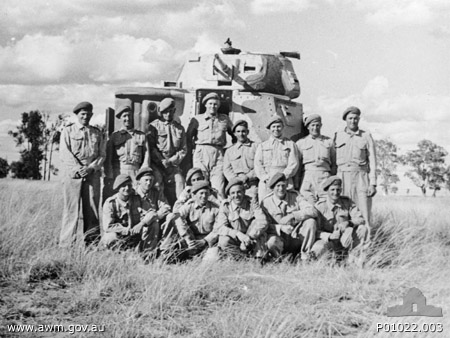
Australian M3 Grant from the 1st troop, C Squadron, 2/4th Armoured Regiment training in Australia, Murgon, Queensland 1942 – Credits : Collection Database of the Australian War Memorial.
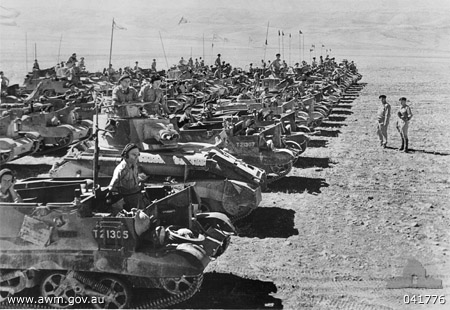
Australian Cavalry Regiment, Syria 1941, inspected after a successful action. We can see Universal Carriers and Mark VI light tanks – Credits : Collection Database of the Australian War Memorial.
.jpg)
Bren Carriers of the 13/33rd infantry battalion training in 1943, NSW Australia – Credits : Collection Database of the Australian War Memorial.
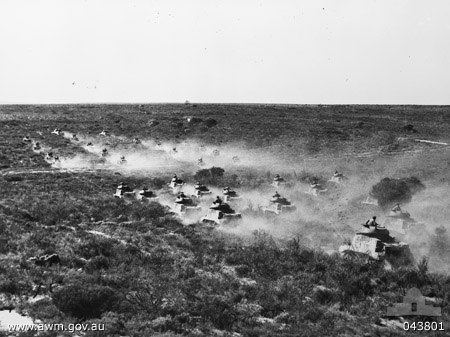
The 2-10 Armored Regiment training with M3 Grants, for night movement formations. Mingenew, WA, 1943 – Credits : Collection Database of the Australian War Memorial.
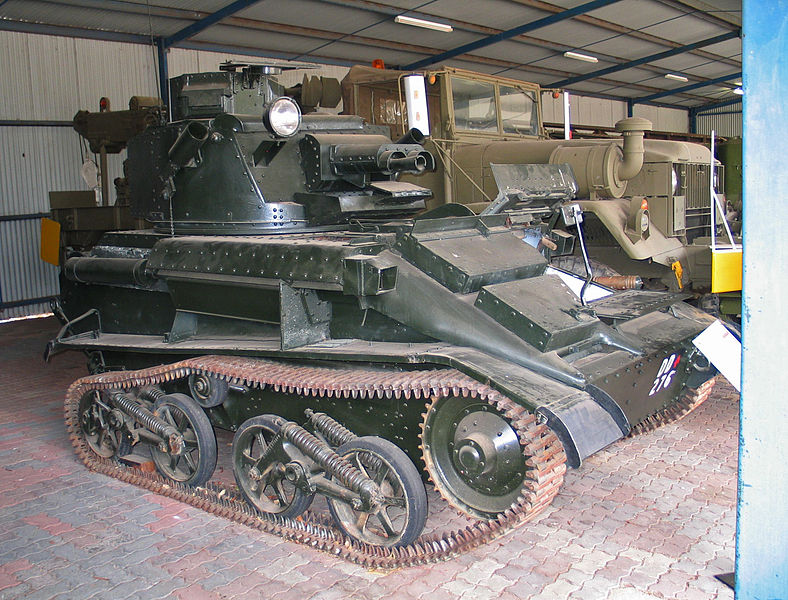
Light Mark VI at the Puckapunyal museum – Credits: Wikipedia commons.
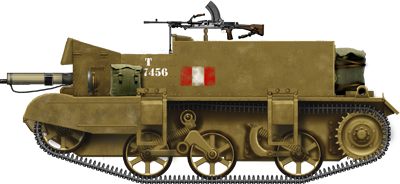
Australian-built Bren Carrier LP2, 1942 (offscale). The glacis plate is at a much steeper angle than that seen on British-produced ones.
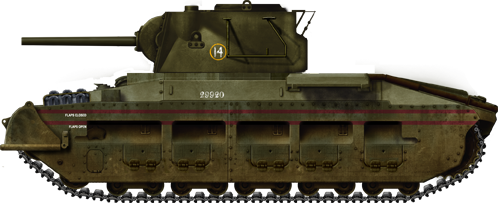
Australian Matilda IICS, ANZACS 1st Tank Battalion, battle of Huon (New Guinea), January 1944.
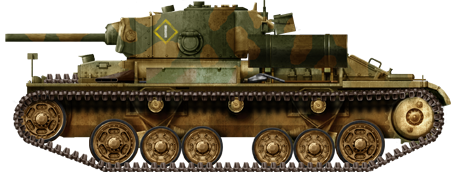
Valentine Mark V CS, 3rd Special Tank Squadron, Green Island, Pacific, February 1944.
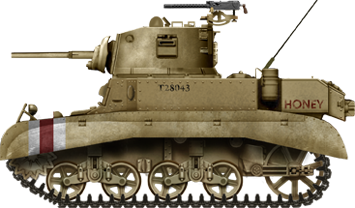
Stuart Mark 3 from an Australian cavalry unit at the first battle of El Alamein, June 1942.
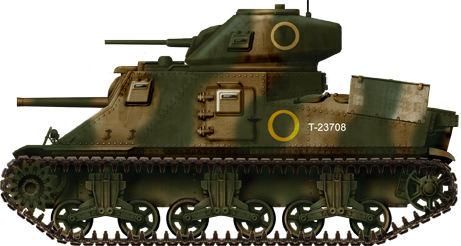
Australian M3 Grant, 2/9th Armoured Regiment, 1942.
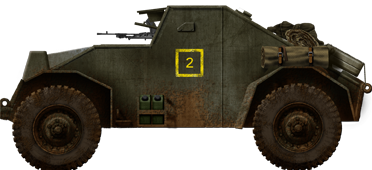
Green factory livery, 1942.
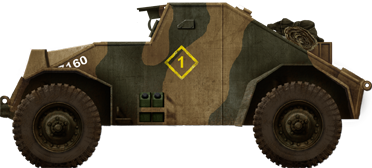
Camouflaged Dingo, 1943
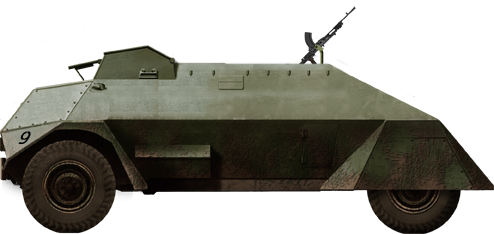
Rover LAC Mk.I “Long” built on the F60L chassis, 1942.
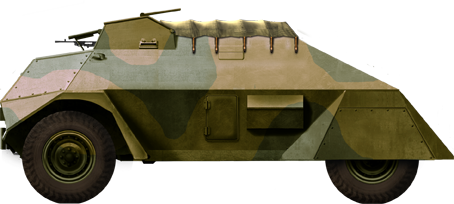
Camouflaged Rover LAC Mk.II, short F60S chassis, 1943.

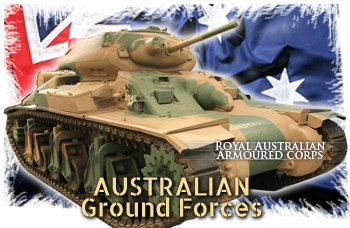
14 replies on “Commonwealth of Australia (WW2)”
Disappointing lack of detail on the Sentinal given how remarkable it was. First tank ever to have fully cast armour, first tank to mount a 17pndr. All this from a country with no previuous experience
Hello Stephen,
Not sure about the “First tank ever to have fully cast armour”, arguably the Hotchkiss h35, Renault R35 and Somua S35 all had a mostly cast hull too. However yes, it was the first to sport the 17-pdr. These points were highlighted in the text.
Hi, thanks for the reply. Just looked through Mjr Gen. R. Hopkins book Australian Armour. (Published by Puckapunyal museum) He says because they had no means to roll armour plate the entire tank was cast. So in that regard I think it’s quite a ground breaker. Also I have seen claimed once before that we used the Firefly. Both in this book and through persnal conversations with tank veterans I don’t think this is correct. Anyway hope this is helpful to your research. Great site. Only just discovered it.
Sorry to dissapoint, but sentinel was a terrible tank, and by no means groundbreaking
Ground breaking in the way it was made, regardless of performance.
Yes interior layout was horrendous, it would not have been efficient or comfortable to fight in. Whilst they pioneered in manufacture they regressed in badly in other aspects.
These gentlemen above or should I say have commented previously on the only Australian designed and manufactured AFV’s, the AC-1 Sentinel, AC3 Thunderbolt and AC III “Scorpion, forget one important thing. At the time the Australian People consisted of only 6,000,000 souls. Now below is a list of tanks, taken from Wikipedia ( I’m in a hurry and yes some of the tanks make me wonder to what criteria they are using to decide, but then I think they are comparing the non Australian tanks to all 3 of the AC-1, AC-3.;ACIII
Tanks of comparable role, performance, and era
British Cromwell Canadian Ram II German Panzer IV Hungarian Turán III Italian Carro Armato P 40 Japanese Type 3 Ci-Nu Soviet T-34 Swedish Stridsvagn m/42 United States M4 Sherman
Like I said I’m in a hurry ( I have to go to bed so I can work tomorrow and feed my family of 6 persons ) so could any of the above or possibly new subscribers write in and list the populations of the countries who made the above AFV’s? I think then that I will prove my point! And none of the Countries, save possibly Canada were anywhere near being only 150 years old.
Australia had always ( and again since 1983 ) been dissuaded in developing manufacturing industry and therefore a cadre of designers and etc. This country possesses every mineral known to man ( except intelligent and incorruptible leadership ) and possesses almost every climate required to grow almost every foodstuff. Which is a sad indictment on those who have smothered our industrial expansion. Except – for one man Prime Minister John Curtin! In WW2 ( his term was 1939 to 1945 ) Australia produced the above 3 AFV’s, 25 pounder howitzers, invented our own highly advanced machine pistol ( Rate of fire 500 rpm ), we built 50 Corvettes, where had never built one before. We built factories which churned out Rifles, Pistols, SMG’s, light machine guns, heavy machine guns, grenades, ammunition of any caliber. We, who had virtually no aircraft industry, designed and produced 2 types of planes and flew them in combat against the Japanese. As I write there are some things that keep springing to mind and I know there are things I can not think of just now. But I must stop now as I really do need to go bye byes!
Robert
John Curtin was elected to Commonwealth House of Representatives in 1934 for the Seat of Curtin in Western Australia. He served as Prime Minister from 1941 to 1945.
The RAAC never operated the Valentine. The Kiwis did. I am unsure why you have listed as being used by the RAAC. What is your source for it, please?
Hi Brian
Thanks for your comments.
This article is out of date and, like some of our other national summary pages, is due for a rework in the near future. It was originally written as a Joint Australia – New Zealand page, however the Kiwis have since been split off onto their own page to cover their own vehicles. Unfortunately during the separation of the two topics some elements got left behind as our original writers weren’t 100% sure what vehicles belonged to which nation, hence why the Valentine and Sherman Fireffly are incorrectly listed on the Australia page and not the New Zealand page. When the page is re-written we will sort it all out, this time with substantially more accurate information for both nations
TE Moderator, Australian Armoured Vehicles specialist
The ACIII was never officially named “Thunderbolt”. It was always designated simply as another version of the Sentinel. Only three ACIIIs IIRC were constructed. ACIV was also another Sentinel and only four or so were every partially constructed.
Thunderbolt was an official name used for the AC III, it appears in several cases of official documentation held in the National Archives of Australia, although much like the name ‘Sentinel’, it appears much less frequently than ‘AC III’ or ‘Mark III’ which was the more common terminology used by the Directorate of Armoured Fighting Vehicle Production and the army. In total one AC III vehicle was completed (tank number 8066) and had completed initial trials when the Australian Cruiser Tank program was cancelled in mid 1943, another ~25 tanks were in various states of completion on the production line at Chullora in preparation for army acceptance tests, with between 80-120 other hulls and turrets cast and being prepared for assembly at the Bradford & Kendall foundries. Tank 8066 is held in the collection of the Australian War Memorial, although it is not on public display, additionally the official listing of the tank in the AWM collection labels it as AC III ‘Thunderbolt’.
No completed AC IV vehicles were produced. An experimental vehicle was constructed by combining a new turret and 17 pounder gun mounting on the E1 prototype hull (the first Prototype AC 1) and went through several rounds of test firing between October 1942 and the cancellation of the project in mid 1943. The actual AC IV design was never completely finalised, the initial design was simply going to be an AC III hull with an improved turret and 17 pounder gun. However the army was not satisfied with the projected ammunition capacity and internal space of such a design, and authorised increased to the width and length of the design to increase the internal volume and turret ring size, the revised version was called AC IVA and was also not finalised before mid 1943.
TE Moderator, Australian Armoured Vehicles specialist
Apart from the locally produced “Dingo” scout car (which looked nothing like the UK’s produced “Dingo” scout car), Australia also produced the Rover Mk.I and Mk.II armoured personnel carrier and the experiment “Rhino” heavy armoured car.
In addition, while we experimented with the Matilda Hedgehog and the M3 Lee/Grant BARV neither went into production. Only the Matilda Dozer and Frog (flamethrow) vehicles went into service, along with various versions of the M3 Lee/Grant tank.
In addition the RAAC also operated various “odds and sods” AFVs such as the Marmon Herrington light tanks, M3 Stuart light tanks and so on, in small numbers.
The Local Pattern Carriers were welded, not riveted like their British counterparts. They featured as standard a Vickers MMG in the bow, plus a large, horizontal air intake across the top of the vehicle just behind the driver’s position.
We have articles scheduled for the Australian armoured cars, they’re currently in the preliminary stages of research.
The Matilda Hedgehog did enter service in a limited capacity, 6 were constructed and issued to 2/4 Armoured Regiment for trials in the pacific, however the war ended before they could be used and additional testing continued in Queensland until the end of 1945 when development was discontinued. Additionally 6 M3 Medium tanks were in the process of being fitted with Hedgehog equipment but were not completed when the project was ended in 1945. An upcoming article on the Hedgehog is just being finished off and will be added to the site shortly, it contains a lot of new and interesting information and some photos that have not previously been published.
The M3 BARV was a post war conversion that was only used for testing, there was also a similar vehicle built from a caterpillar bulldozer (if I recall it still exists at the RAAC museum Puckapunyal).
The Marmon Herrington light tanks and the Marmon Herrington tractor arrive in Australia as ‘Refugee cargo’ intended for the Dutch East Indies (modern Indonesia). They were given limited testing before being deemed unsuitable and taken apart so that the engines could be put to other use.
The M3 light tank was initially used by 9 Division Cavalry Regiment in the middle east alongside British Crusader tanks, and the various Armoured Regiments raised in Australia also operated M3 light tanks extensively alongside their M3 mediums on training excercises. However only the 2/6 Armoured Regiment and the 9 Division Cavalry Regiment used the M3 in combat. Due to a lack of available tanks the 3 Divisional Cavalry Regiments (6,7 and 9) did make use of an odd mix of vehicles such as obsolete British light tanks and captured Italian and French vehicles in limited numbers in the Middle East.
The initial production run of LP1 carriers were of riveted construction, although there were only a few hundred LP1 carriers produced. The LP2/LP2A carrier (and the developmental vehicle chassis no# 160) were of welded construction using locally developed Australian Bullet proof Plate number 3 (ABP3). Initially LP1 and LP2 carriers were fitted to mount the Vickers MG in the bow, and can be identified by a flat armour plate located above the gun port for the MG with a hinge pivot on one side, the hinge was required to mount/demount the vickers gun as the cooling jacket was too wide to fit through the gun port. Later vehicles were fitted for Bren guns and can be identified by an angled armour plate that projects forward above the gun port. As the Bren was much smaller than the Vickers it could be mounted/demounted from the vehicle without needing a hinged opening, however due to the top mounded magazine the angled plate was required to allow the gun to be aimed downwards and to allow for magazines to be changed. The angled plates on the later vehicles also incorporated the hinge of the earlier vehicles so a Vickers gun could still be mounted in place of the Bren.
TE Moderator, Australian Armoured Vehicles specialist